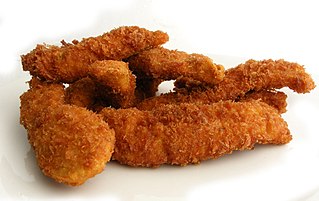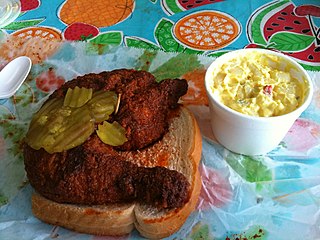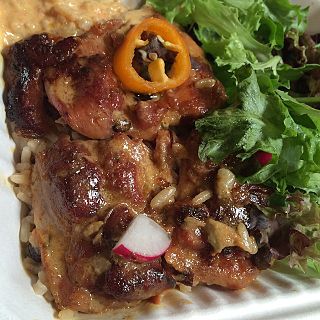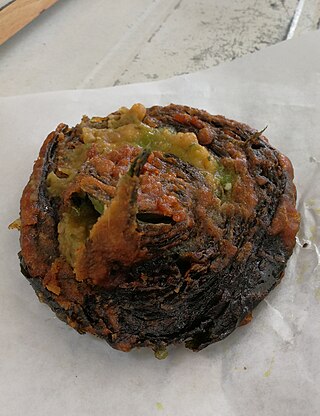
The cuisine of the American Midwest draws its culinary roots most significantly from the cuisines of Central, Northern and Eastern Europe, and Indigenous cuisine of the Americas, and is influenced by regionally and locally grown foodstuffs and cultural diversity.

A hamburger, or simply a burger, is a dish consisting of fillings—usually a patty of ground meat, typically beef—placed inside a sliced bun or bread roll. The patties are often served with cheese, lettuce, tomato, onion, pickles, bacon or chilis with condiments such as ketchup, mustard, mayonnaise, relish or a "special sauce", often a variation of Thousand Island dressing, and are frequently placed on sesame seed buns. A hamburger patty topped with cheese is called a cheeseburger. Under some definitions, a burger is considered a sandwich.

Fast food is a type of mass-produced food designed for commercial resale, with a strong priority placed on speed of service. Fast food is a commercial term, limited to food sold in a restaurant or store with frozen, preheated or precooked ingredients and served in packaging for take-out or takeaway. Fast food was created as a commercial strategy to accommodate large numbers of busy commuters, travelers and wage workers. In 2018, the fast-food industry was worth an estimated $570 billion globally.

Trinidad and Tobago has a unique history and its food is influenced by Indian-South Asian, West African, Creole, European, American, Chinese, Amerindian, and Latin American culinary styles. Trinidadian and Tobagonian food is dominated by a wide selection of dishes, most notably, doubles, roti, pelau, callaloo and curried crab and dumplings. Trinidad and Tobago is also known for its prepared provisions, such as dasheen, sweet potato, eddoes, cassava, yam, soups and stews, also known as blue food across the country. Corresponding to the Blue Food Day event held annually in Trinidad and Tobago.

Church's Texas Chicken is an American fast food restaurant chain that specializes in fried chicken and is headquartered in Atlanta, Georgia. The chain was founded as Church's Fried Chicken To-Go by George W. Church Sr. in April 1952, in San Antonio, Texas, across the street from The Alamo. Church's Texas Chicken trades as Texas Chicken or Church's Chicken in many countries. The chain is owned by American private equity firm High Bluff Capital Partners. As of 2017, Church's Texas Chicken had more than 1,700 franchised and company-owned locations in 26 countries.

Chicken fingers are chicken meat prepared from the pectoralis minor muscles of the animal. These strips of white meat are located on either side of the breastbone, under the breast meat. They may also be made with similarly shaped pieces cut from chicken meat, usually the breast, or sometimes just pulverized chicken flesh.

Cluck-U Chicken, also known as Cluck University, is an American quick-serve restaurant chain, with most locations in the U.S. states of Maryland and New Jersey, but there are locations in Pennsylvania as well as one location in Ohio and one international location in Lebanon, Kuwait, and the UAE. There were previously several other locations, including Delaware, Florida, Chapel Hill NC, and Washington, D.C. as well as a location in Fort Collins, CO.

BK Chicken Fries are a fried chicken product sold by the international fast-food restaurant chain Burger King. At the time of their introduction in 2005, the company had intended Chicken Fries to be one of their larger, adult-oriented products made with higher-quality ingredients than their standard menu items. Additionally, the product further targeted the snacking and convenience food markets with a specific packaging design that was intended to be easier to handle and fit into automotive cup holders. The product was part of a series of product introductions designed to expand Burger King's menu with both more sophisticated fare and present a larger, meatier product that appealed to 24- to 36-year-old males. Along with this series of larger, more complex menu products, the company intended to attract a larger, more affluent adult audience who would be willing to spend more on the better-quality products. They were discontinued in the United States in 2012, but continued to be sold in some markets, such as Italy. In August 2014, they were reintroduced for a limited-time offering (LTO) in North America, leading to their permanent re-addition to the menu in March 2015 in over 30 countries globally.
McDonald's Corporation is the world's largest chain of fast food restaurants, serving around 68 million customers daily in 119 countries. McDonald's traces its origins to a 1940 restaurant in San Bernardino, California, United States. After expanding within the United States, McDonald's became an international corporation in 1967, when it opened a location in Richmond, British Columbia, Canada. By the end of the 1970s, McDonald's restaurants existed in five of the Earth's seven continents; an African location came in 1992 in Casablanca, Morocco.

The cuisine of Michigan is part of the broader regional cuisine of the Midwestern United States. It is reflective of the diverse food history of settlement and immigration in the state, and draws its culinary roots most significantly from the cuisines of Central, Northern and Eastern Europe, and Native North America.

Hot chicken is a type of fried chicken that is a local specialty of Nashville, Tennessee, in the United States. In its typical preparation, it is a portion of breast, thigh or wing that has been marinated in a water-based blend of seasoning, floured, fried and finally covered in a paste or sauce that has been spiced with cayenne pepper. This method of preparation originates within African American communities in the Southern United States. A richly pigmented seasoning paste gives the fried chicken its reddish hue. Spice blends, preparation methods and heat intensity vary from recipe to recipe or depending on the chef.

Bake and shark is a traditional fast food dish of Trinidadian cuisine prepared using fried flatbread, shark meat and additional ingredients. It is a classic street food dish that is sold at a multitude of food stalls and cookshops all over Trinidad and Tobago.

KFC was founded by Colonel Harland Sanders, an entrepreneur who began selling fried chicken from his roadside restaurant in Corbin, Kentucky, during the Great Depression. Sanders identified the potential of restaurant franchising, and the first "Kentucky Fried Chicken" franchise opened in Salt Lake City, Utah, in 1952. KFC popularized chicken in the fast-food industry, diversifying the market by challenging the established dominance of the hamburger. Branding himself "Colonel Sanders", the founder became a prominent figure of American cultural history, and his image remains widely used in KFC advertising. The company's rapid expansion made it too large for Sanders to manage, so in 1964 he sold the company to a group of investors led by John Y. Brown Jr. and Jack C. Massey.

Buljol is a salad dish of the cuisine of Trinidad and Tobago. It consists of chopped salted cod, tomatoes and chilies. The name is of French origin. 18th-century colonial power Spain launched the cédula de población in 1783, an edict that successfully promoted the settling of French planters in Trinidad who quickly set the population majority. The name is a combination of the French words brulé ('burnt') and gueule ('muzzle'), which was changed into bu'n jaw in Trinidad's 19th century patois and finally morphed into buljol. The name does not relate to the temperature of the dish but to its spiciness, caused by the added hot pepper.

Pelau is a traditional rice dish from the West Indies (Guadeloupe, Dominica and Caribbean countries such as Trinidad and Tobago, Grenada and the Virgin Islands. Its main ingredients typically include meat, rice, pigeon peas or cowpeas, coconut milk and sugar. Various vegetables and optional spices can be added. Common spices used in the dish are cardamom, cloves, cumin, and coriander. The meat is caramelised in brown sugar along with onion and garlic and the other ingredients are then added one by one, resulting in a dark brown stew.

Saheena is a street food and snack of Indian origin in the cuisine of Trinidad and Tobago.















